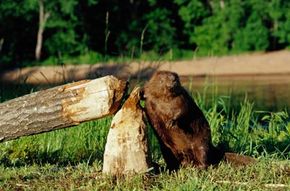Aside from making cozy homes for their families and their friends, beavers play a leading role in nature's big picture when they build dams. More than most other environments, wetlands depend heavily on beaver dams. Although in the United States they've suffered from urban development and pollution, wetlands host a variety of animal species. One nonprofit organization devoted to beavers claims that almost half of endangered and threatened species in North America rely upon wetlands [source: BWW]. Wetlands also absorb large amounts of water, which counteracts the effects of heavy rainfall and can prevent potential floods. In addition, beaver dams act as natural filters that keep sediment and toxins from flowing into streams and on into oceans.
Although beavers play an important role in the ecosystem, they can also cause problems that are sometimes more than a nuisance. Beaver dams can actually cause flooding. This can wipe out land that farmers need for crops or livestock. Experts estimated that the U.S. timber industry suffered more than $22 million in damage in a single year due to flooding caused by these dams [source: Vantassel, et al]. It doesn't stop there. This flooding can endanger public safety by saturating the soil and making roads, bridges, train trestles and levees unstable. Also, beavers, with their sharp teeth, can chew through valuable, rare or important trees, and felled trees can pose a hazard to utility lines and buildings.
Government agencies, environmental organizations and others work with landowners and farmers to come up with environmentally-responsible methods of beaver dam control. Sometimes it's by humanely trapping and removing the beavers, although more beavers often move in. In other cases, landowners use beaver pipes -- corrugated plastic pipes stuck in a beaver dam and routed to a specific location -- to control and prevent flooding caused by dams. Yet others build pre-dams -- fences that encourage beavers to build in a desired location [source: Brown, et al].
Another tactic is to install specially-designed fences in waterways to keep beavers from building there in the first place. Low-voltage electric fences are also used to keep beavers off of land -- a concept similar to fencing cow pastures.
What's more, some people paint trees with a special repellant that keeps beavers away. Homeowners can wrap the lower portion of smaller trees and ornamental shrubs with wire, but it's not effective for keeping beavers from chewing on large trees. In some situations, government agencies compensate those who guard beavers and their wetland habitats.
Depending on whom you ask, the busy beaver and his powerful dam can be a blessing or a curse. For more information about beavers, beaver dams and other related topics, follow the links on the next page.
